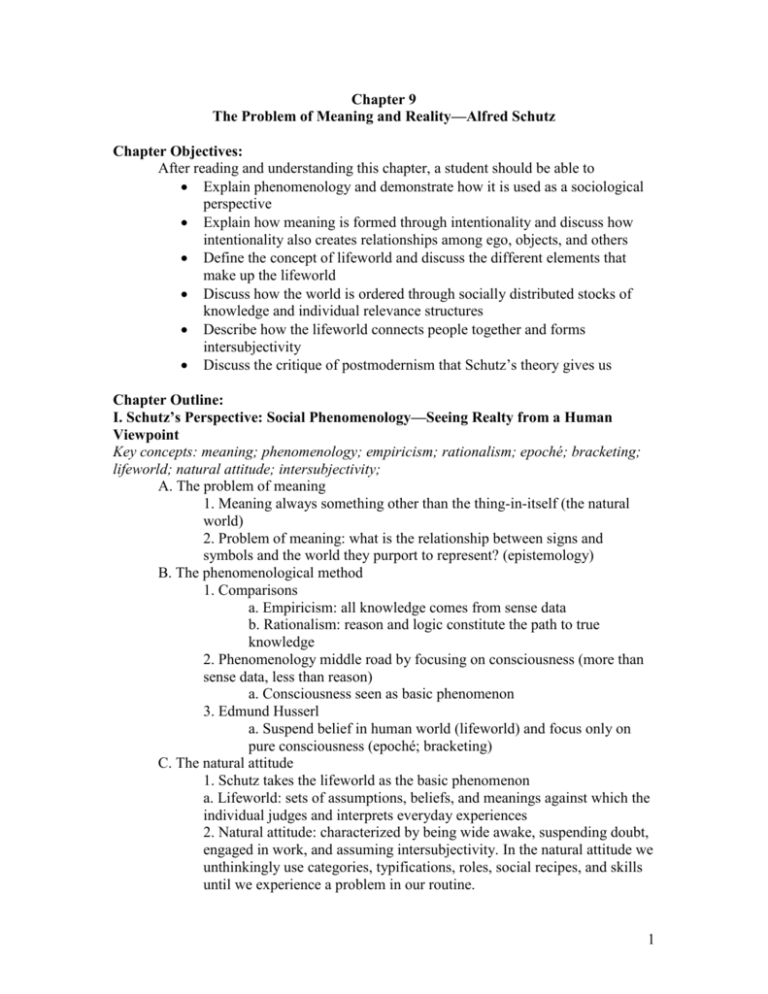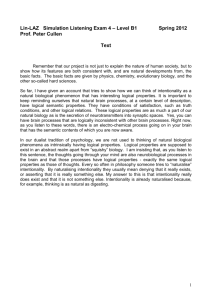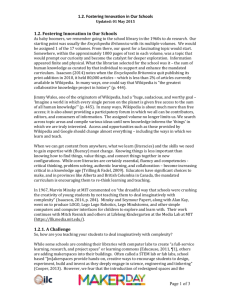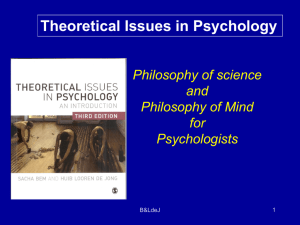Chapter 9
advertisement

Chapter 9 The Problem of Meaning and Reality—Alfred Schutz Chapter Objectives: After reading and understanding this chapter, a student should be able to Explain phenomenology and demonstrate how it is used as a sociological perspective Explain how meaning is formed through intentionality and discuss how intentionality also creates relationships among ego, objects, and others Define the concept of lifeworld and discuss the different elements that make up the lifeworld Discuss how the world is ordered through socially distributed stocks of knowledge and individual relevance structures Describe how the lifeworld connects people together and forms intersubjectivity Discuss the critique of postmodernism that Schutz’s theory gives us Chapter Outline: I. Schutz’s Perspective: Social Phenomenology—Seeing Realty from a Human Viewpoint Key concepts: meaning; phenomenology; empiricism; rationalism; epoché; bracketing; lifeworld; natural attitude; intersubjectivity; A. The problem of meaning 1. Meaning always something other than the thing-in-itself (the natural world) 2. Problem of meaning: what is the relationship between signs and symbols and the world they purport to represent? (epistemology) B. The phenomenological method 1. Comparisons a. Empiricism: all knowledge comes from sense data b. Rationalism: reason and logic constitute the path to true knowledge 2. Phenomenology middle road by focusing on consciousness (more than sense data, less than reason) a. Consciousness seen as basic phenomenon 3. Edmund Husserl a. Suspend belief in human world (lifeworld) and focus only on pure consciousness (epoché; bracketing) C. The natural attitude 1. Schutz takes the lifeworld as the basic phenomenon a. Lifeworld: sets of assumptions, beliefs, and meanings against which the individual judges and interprets everyday experiences 2. Natural attitude: characterized by being wide awake, suspending doubt, engaged in work, and assuming intersubjectivity. In the natural attitude we unthinkingly use categories, typifications, roles, social recipes, and skills until we experience a problem in our routine. 1 D. Creating meaning 1. Schutz’s critique of Weber’s understanding of meaning attribution: rational behavior; goal directed 2. Schutz: meaning after the fact (intentionality) II. Being Conscious in the Lifeworld Key concepts: lived experience; intentionality; noema; I-pole; object-pole; intentional horizon; reflexive construction A. Lived experience and intentionality (Figure 9.1) 1. Fundamental experience of life: stream of undifferentiated experiences—internal time-consciousness a. Pure experience without meaning 2. Meaning comes from intentionality (a mental perception that involves intentional objects, intended behaviors, and, thus, relations between the ego (self) and sets of intentional objects and behaviors) a. Aimed at an object, experience, or emotion that has already occurred b. Can include noema (imaginary or symbolic objects) c. Includes relationship between the person and object (I-Pole and Object-Pole of intentionality) d. Intentionality is subjective quality of individual i. However, intentionality is always directed by and toward cultural objects (thus, social) e. Intentionality implies reflexive construction of social reality III. Ordering the Lifeworld—Creating Human Reality (Figure 9.2) Key concepts: social scalpel; stocks of knowledge; typifications; relevance structures; inorder-to; because-of; attitudes A. Reality as social order 1. Categories/typifications as social scalpel—dividing up internal timeconsciousness B. Ordering through stocks of knowledge 1. Stocks of knowledge: the cultural information that is available to any group. They are “what everybody knows” and thus aid in the taken-forgrantedness of cultural reality. 2. Typifications: social types or categories through which we understand ourselves and others. People appear to us as variations of the average expectations associated with a social type. a. Typifications are reciprocally held b. Stocks of knowledge not necessarily ordered and logical—the interest is pragmatic (we experience our self as working at something) i. Any changes to typifications are minimal and only pragmatically motivated C. The social distribution of stocks of knowledge 1. Stocks of knowledge differentially distributed by social position 2 2. Example: class—Bourdieu’s theory a. Level of education (scholasticism v. classicism) b. Distance from necessity D. Individual ordering through relevance structures: hierarchically arranged structure of contexts and situations that is important for the individual; ordered through 1. “In-order-to” motivations: ordering through personal projects 2. “Because-of” motivations: linked to attitudes IV. Connecting With Others Key concepts: solipsism; intersubjectivity; reciprocity of perspectives; taken-forgrantedness; anonymization; Thou-orientation; We-orientation; They-orientation A. The problem of solipsism 1. Descartes and hyperbolic doubt 2. Solipsism: everything is reduced to the individual—the self can know nothing but its own state a. Ideas, motivations, perceptions, and the like are all abstractions from individual’s own inner experience B. Subjectivity is basically objective and intersubjective 1. Solipsism’s false premise: assumes that the individual experiences the world primitively or independently, that human experience works from the inside out But the experience of the individual self is of the lifeworld, which is made up from stocks of knowledge and typifications 2. Lifeworld is a world of relationships—I-pole and object-pole of intentionality includes both objects and other people a. Lifeworld is arranged into associates, contemporaries, predecessors, and successors—subjective awareness then is of one living in the midst of multiple others 3. Lifeworld experienced through reciprocity of perspectives—two assumptions a. Standpoints are interchangeable b. Any differences are irrelevant for the purposes at hand 4. Results in taken-for-grantedness of lifeworld C. Making others anonymous 1. Because people are experienced through typifications, all others are subject of varying degrees of anonymization 2. Anonymization varies by orientation toward other—two basic spheres a. The field of “I-Thou-We” b. The field of “They-orientation” V. Thinking About Postmodernity Key concepts: A. The postmodern problem: increasing importance of yet decreasing meaningfulness of culture and, thus, identity 3 1. Based on assumption of correlation among culture, meaning, and identity B. The micro-foundations of meaning—Schutz’s theory provides a critique of postmodern idea of fractured meanings and selves 1. Meaning is created subjectively— while the individual uses stocks of knowledge, this use is driven by the individual’s subjective awareness of the world and pragmatic valences 2. Three levels of coherence produced by individual a. Durée: pure experience in unmarked time (unity exists below the level of conscious awareness, but they form a basic sense of unity in life and self for the individual) b. Intentionality is pragmatically motivated (heterogeneous and incoherent worlds are thus not an issue) c. Production of meaningful wholes out of separate experiences, which in turn become an object for intentionality Chapter Summary: To think like Schutz is to focus on the problem of meaning. Meaning always implies a difference between objects and experiences on one hand, and the meaning attributed to them on the other. In order to understand how people cope with the problem of meaning, Schutz concentrates his work on the natural attitude in the lifeworld. Meaning is specifically created through intentionality. Intentionality implies that meaning is subjective and is created through a backward accounting. But intentionality involves more than simply paying attention to a thing. Intentional objects are perceived in fields of actions and relationships. Because intentionality places the individual in an action mode toward the object, meaningful objects end up being reflexively constructed. In addition to physical objects, experiences, and other people, symbolic worlds can be the object of intentionality. The world toward which we become intentional is an already existing ordered lifeworld. Stocks of knowledge are socially produced and impose an order on the universe and human experience within it. These stocks of knowledge are available to every one of us and are minimally modified as individuals encounter problems or differences that their stocks of knowledge do not cover. Pragmatically sufficing generates a taken-for-grantedness about and continuity for social meaning, thus making it appear real and objective. Stocks of knowledge are further ordered through social differentiation and individual structures of relevance. The production of meaning may imply the problem of solipsism—reduction of all meaning and reality to individual experience. However, posing this problem overlooks the fact that collective stocks of knowledge, in particular, language, are the primary data that individuals must master. That being the case, meaning and reality are intrinsically objective and intersubjective. In other words, meaning is always formed in, around, and through relations with others. We understand the meaning of self and other through stocks of knowledge and, specifically, typifications. This implies that varying degrees of anonymity are associated with meaning production. 4 Quite a bit of postmodern theory focuses on the relationships among capitalism, mass media, and meaning. The argument is basically a structural one wherein problems created at the macro level produce almost automatic effects for people. Thus, because capitalism and mass media have trivialized and fragmented culture, the individual’s experience of meaning, reality, and self are fragmented and flat as well. However, Schutz’s theory is a micro level theory of meaning production. Because people are pragmatically motivated to create meaning, and because meaning is produced through intentionality (a reflexive glance that synthesizes discrete and diverse experiences into a whole narrative), then the postmodern concerns about culture at the macro level may be misplaced. 5






